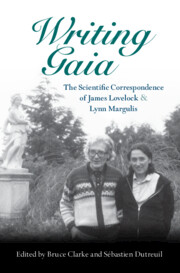Book contents
- Writing Gaia: The Scientific Correspondence of James Lovelock and Lynn Margulis
- Reviews
- Writing Gaia: The Scientific Correspondence of James Lovelock and Lynn Margulis
- Copyright page
- Epigraph
- Table of Contents
- Figures
- Contributors
- Foreword by James Lovelock
- Preface
- Acknowledgements
- Introduction
- Part I 1970–1972
- Part II 1973–1979
- Part III 1980–1991
- 1980
- 1981
- 1982
- 1983
- 1984
- 1985
- 1986
- 1987
- 1988
- 1989
- 1990
- 1991
- Part IV 1992–2007
- Part V Commentaries on Lovelock and Margulis
- Glossary of Names
- Glossary of Terms
- Bibliography
- Index
1980
from Part III - 1980–1991
Published online by Cambridge University Press: 28 July 2022
- Writing Gaia: The Scientific Correspondence of James Lovelock and Lynn Margulis
- Reviews
- Writing Gaia: The Scientific Correspondence of James Lovelock and Lynn Margulis
- Copyright page
- Epigraph
- Table of Contents
- Figures
- Contributors
- Foreword by James Lovelock
- Preface
- Acknowledgements
- Introduction
- Part I 1970–1972
- Part II 1973–1979
- Part III 1980–1991
- 1980
- 1981
- 1982
- 1983
- 1984
- 1985
- 1986
- 1987
- 1988
- 1989
- 1990
- 1991
- Part IV 1992–2007
- Part V Commentaries on Lovelock and Margulis
- Glossary of Names
- Glossary of Terms
- Bibliography
- Index
Summary
Letter 119 provides some insight into Margulis’s tenure from 1977 to 1980 as the Chairman [sic] of the Committee on Planetary Biology and Chemical Evolution (PBCE) of the Space Science Board, an organ of the National Research Council in connection with the National Academy of Sciences. This activity was a direct continuation of her professional involvement with NASA’s exobiology initiatives of the 1970s. In the Committee’s report Origin and Evolution of Life: Implications for the Planets, a Scientific Strategy for the 1980s (National Research Council 1981), Lovelock was listed as a consultant to the Committee under Margulis’s chairmanship. The head of the Space Science Board, A. G. W. Cameron, noted in the report’s foreword: This document describes the emerging science of life as a planetary phenomenon. It assesses the status of our knowledge of the origin of life on Earth and of the precursors of life elsewhere in the Galaxy. It also outlines ways in which we can use the capacity that space technology provides to study the biological processes that are important on a global scale in shaping the surface of the Earth and the composition of the atmosphere.
- Type
- Chapter
- Information
- Publisher: Cambridge University PressPrint publication year: 2022

